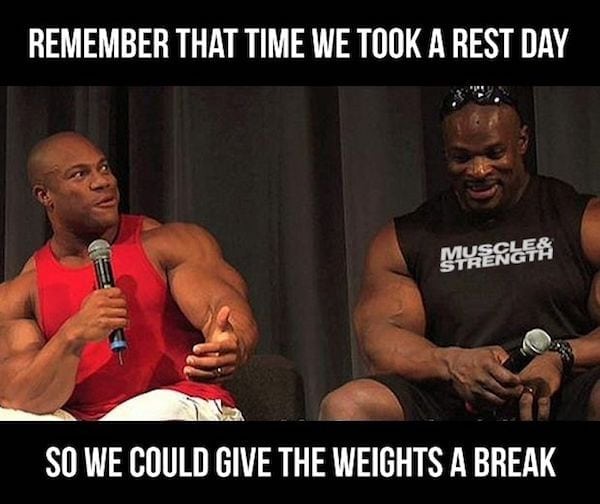No products in the cart.
The Importance of Rest Days – Lift Less, Get Stronger

Whether you are trying to improve your sporting performance, trying to smash it in the gym, or you just want to take up running to get a little fitter there is one thing you are probably neglecting. That thing is rest.
Whilst listening to people who have only been training for a month talk about the dangers of overtraining will make most experienced lifters roll their eyes so hard they go temporarily blind, they aren’t completely wrong.
There are many benefits to getting sufficient rest, and a lot of negative effects that can come if you aren’t getting sufficient rest. This article will explain why rest is so important to your training, and help you to get better results than ever before.[toc]
Why do you Need Rest?

Even if most people intellectually understand that rest and recovery are good things, when it comes down to it deep down most would still think that the extra gym session would give you more benefits.
But the reality is that without rest your muscles won’t have the opportunity to grow, nor will they be able to recover properly.
Without a fully recovered muscle you won’t be able to operate at peak capacity. Now this doesn’t mean that every workout requires 48 hours of rest and recuperation afterwards, but you wouldn’t want to train legs and then immediately train legs 12 hours later would you?
So clearly there is a benefit to resting. But recovery is not the only reason, another is that without rest your muscles would never grow.
Whilst they may temporarily increase in size during exercise (the pump) they soon go back down again after a session. But once this happens your muscles go through a process known as muscle protein synthesis.
This is where your damaged muscle fibres are repaired and rebuilt using protein. This process is responsible for both gains in strength and gains in size (hypertrophy). But the process doesn’t happen immediately and requires increased protein consumption, and increased sleep to be fully effective.
Fat Loss and Rest
But what about fat loss? Well this is where things get complicated, see one of the biggest contributors to your metabolism is not exercise but a process known as Non Exercise Activity Thermogenesis (NEAT).
This is all of the calories that your body burns performing actions that are not considered exercise. For example, walking, cleaning the house, doing the dishes, carrying shopping from the car, and even sitting at a desk typing can burn some calories.
People with higher NEAT tend to have higher metabolisms, and this goes someway to explaining how your mate who can eat anything and never exercises can still be stick thin.
If you pay close attention to them you might find that they actually lead an active life (even if it’s just small things like constantly fidgeting) or walking more than the average person.
But let’s say you have a regular metabolism and NEAT and you decide to perform a HIIT circuit, now a lot of the buzz around HIIT is that it can elevate your fat-burning for hours afterwards.
However this is an over-simplification. Because an unfit person who performed a high intensity exercise circuit would be exhausted afterwards and their NEAT levels would drop. They would need to recover.
Obviously the fitter you are, the more efficient your recovery process is, meaning that you would eventually get all of the benefits of HIIT.
What’s interesting though is that when you sleep after intense exercise your metabolism is actually higher than it would be during waking hours (on a day when you haven’t rested). This means that the more REM sleep you get after a workout, the more calories you would burn.
Your metabolism is raised because your body is trying to recover from the exercise.
So if you have exercised heavily, making sure that you get eight or nine hours sleep will really help you to recover and will also help you increase your fat burning potential.
Active Rest
So what do you do on a designated rest day? The first thing you need to do is hit your protein targets. This will help with recovery and growth.
Make sure that you have had enough sleep (you can nap during the time that you usually spend in the gym if you’re really serious) and if you have the energy/desire you can participate in some active-rest.
This is where you perform light exercises such as swimming, walking, a leisurely bike ride, or just some housework.
You are supposed to be recovering so obviously you don’t want to be putting in 100% effort, but going for a 20 minute walk after work will keep your daily energy expenditure at a reasonable level, and may actually help reduce post-exercise muscle soreness.
Final Thoughts
Sleep lots, eat lots of protein, and keep your NEAT high during a rest day. Even perform some light exercise if you want to. This will give your muscles a chance to fully recover and to grow.
It will also lower Cortisol levels (the stress hormone that can impair muscle growth).
Don’t use the need to rest as an excuse to take 4-5 days off a week, but don’t train 7 days a week and expect to be in peak condition!
Save
Save
Save
